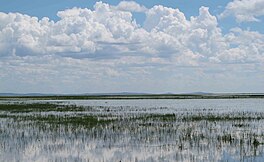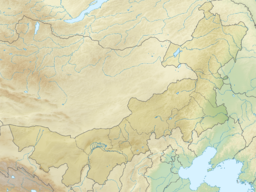Dalai Nur
| Hulun Lake | |
|---|---|
 Panorama of lake with reed beds. | |
| Location | Inner Mongolia (China) |
| Coordinates | 48°58′23″N 117°26′08″E / 48.97306°N 117.43556°E |
| Primary inflows | Kherlen River, Orshuun Gol |
| Primary outflows | Mutnaya Protoka (temporal Argun River−Amur Basin tributary) |
| Catchment area | 33,469 km2 (12,922 sq mi)[1] |
| Basin countries | China, Mongolia |
| Max. length | 90 km (56 mi)[2] |
| Max. width | 27 km (17 mi)[2] |
| Surface area | 2,339 km2 (903 sq mi) |
| Average depth | 5.7 m (19 ft)[1] |
| Surface elevation | 539 m (1,768 ft) |
| Official name | Dalai Lake National Nature Reserve, Inner Mongolia |
| Designated | 11 January 2002 |
| Reference no. | 1146[3] |
Hulun Lake (simplified Chinese: 呼伦湖; traditional Chinese: 呼倫湖; pinyin: Hūlún Hú; Mongolian: Хөлөн нуур, romanized: Khölön nuur; lit. 'foot lake') or Dalai Lake[4][5] (Mongolian: Далай нуур, romanized: Dalai nuur; lit. 'ocean lake') is a large lake in the Inner Mongolia region of northern China.
Description

It is one of the five largest freshwater lakes in all of China, covering approximately 2,339 km2. In years with high precipitation, the normally exit−less endorheic lake may overflow at its northern shore, and the water will meet the Argun River (Ergune) after about 30 kilometres (19 mi).
The lake is not far from Manzhouli, which is on a major passenger rail-line. Although there are several villages nearby, Manzhouli is the nearest city of notable size. As of 1995 annual fish production was about 7,000 tons, 100 tons of shrimp, 4 kilograms of pearls, 1.5 million crayfish. Hulun Lake is also one of the key reed production areas in China.[1]
Hulun Lake and its wetlands are a Biosphere reserve and a Ramsar site of China, Dalai Lake National Nature Reserve.[5][6]
See also
References
- ^ a b c LakeNet - Hulun Hu (Hulun Nur) Lake Profile
- ^ a b measured using Google Earth
- ^ "Dalai Lake National Nature Reserve, Inner Mongolia". Ramsar Sites Information Service. Retrieved 25 April 2018.
- ^ Berkey, Charles Peter; Morris, Frederick Kuhne; Central Asiatic Expeditions (1921–1930), Central Asiatic (1924). "Basin structures in Mongolia. Bulletin of the AMNH ; v. 51, article 5". Bulletin of the American Museum of Natural History. 51: 105. hdl:2246/1317.
The great basin of the Gobi contains many minor basins, which we are calling "talas," from a Mongol word for an open steppe-country (Fig.3). The following talas may be demonstrated: the Dalai Nor tala, now draining through the Argun river to the Amur; the Iren tala; the Gashuin Nor, or Edsin Gol tala; the Kisin or Shargin tala; the Khara and Dzapkhin, or Kirghiz Nor tala, in which are the cities of Kobdo and Uliassutai; the Tez, or Ubsa Nor tala. Each tala has its own local interior drainage and is bounded by inconspicuous warp divides or by mountain ranges, or both, separating it from neighboring areas of similar habit.
{cite journal}: CS1 maint: numeric names: authors list (link) - ^ a b Dalai Lake Biosphere Reserve, China
- ^ Dalai Lake National Nature Reserve, Inner Mongolia
External links
![]() Media related to Hulun Lake at Wikimedia Commons
Media related to Hulun Lake at Wikimedia Commons
